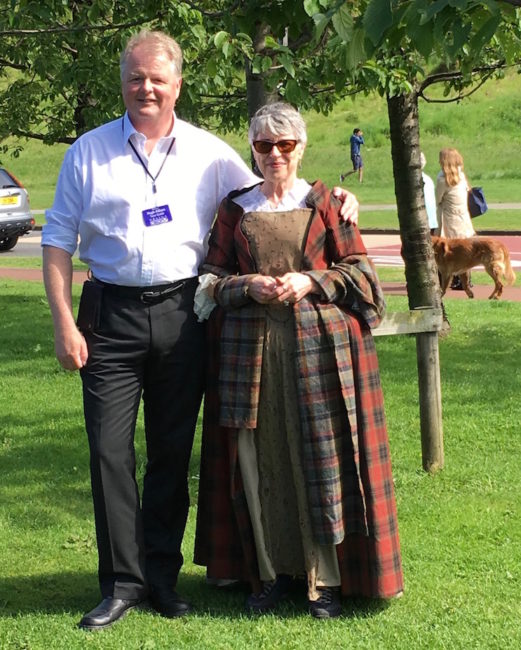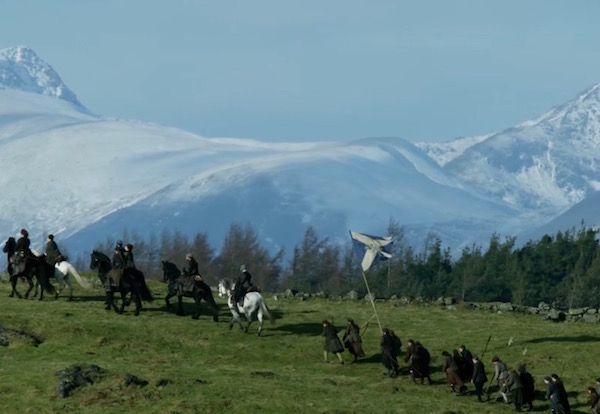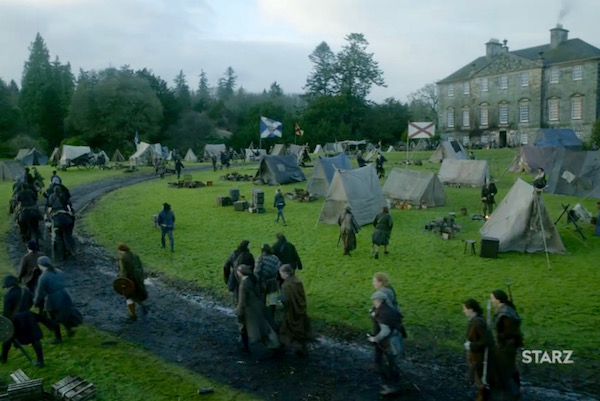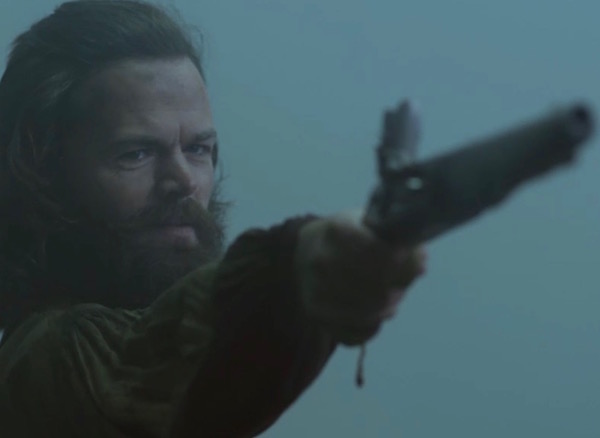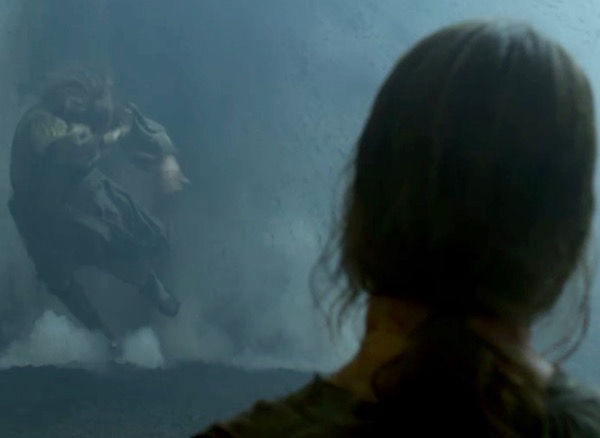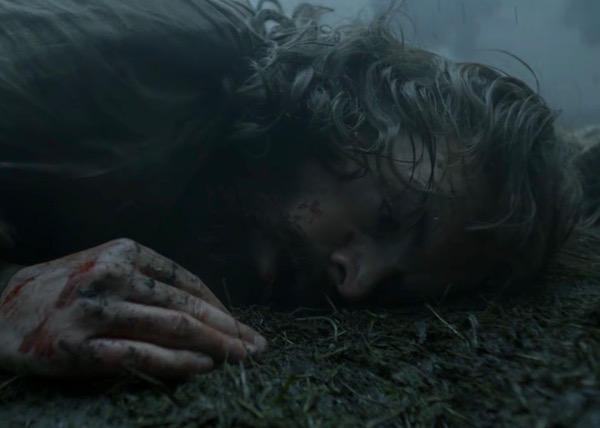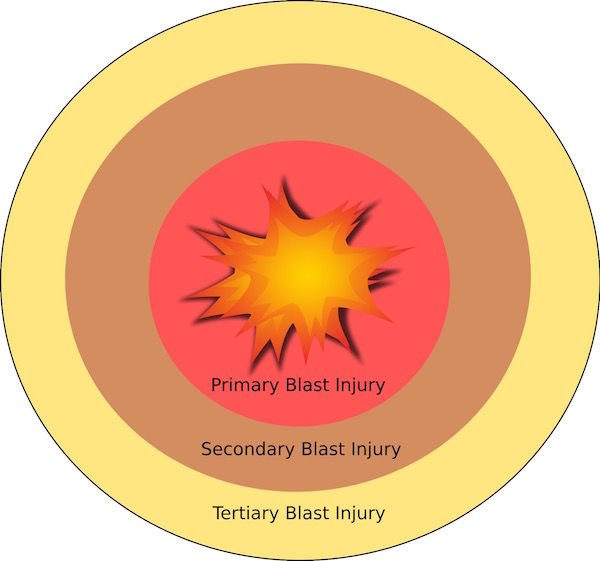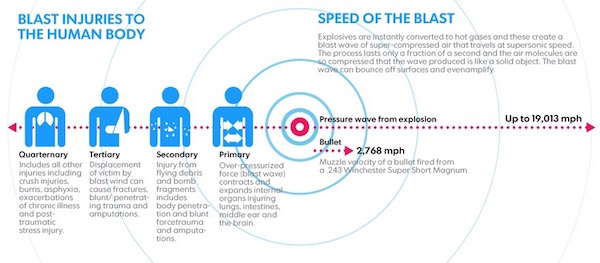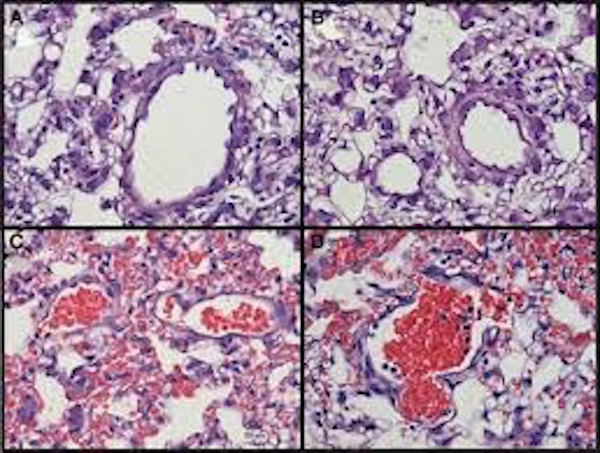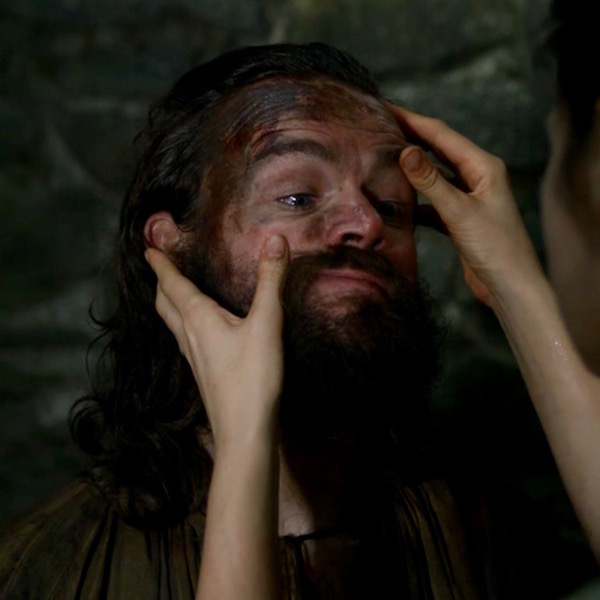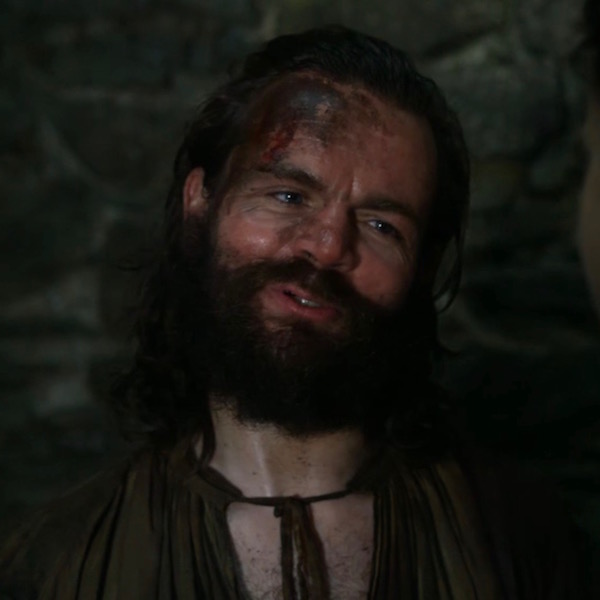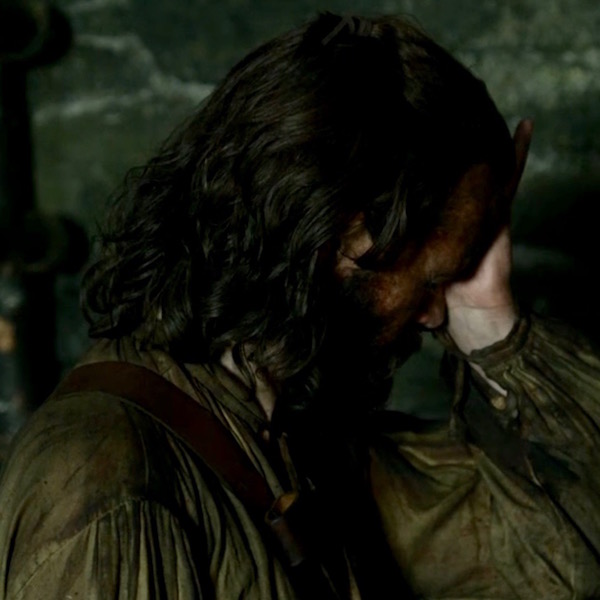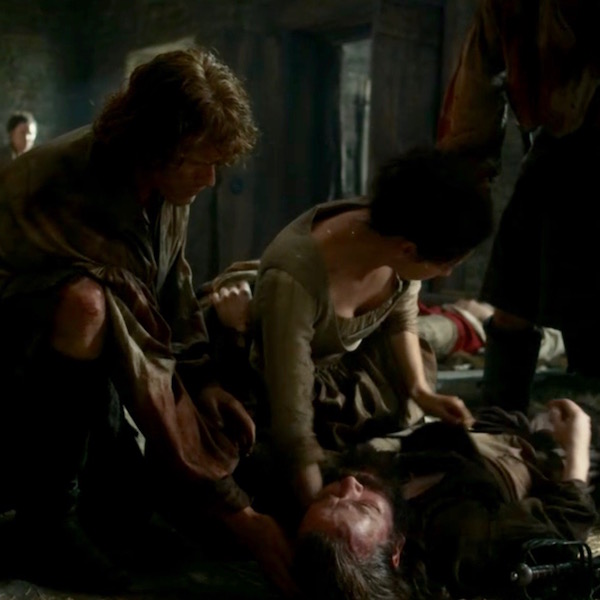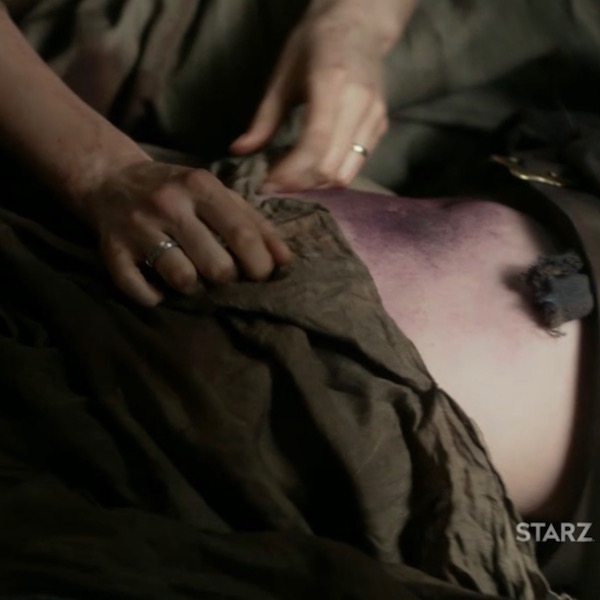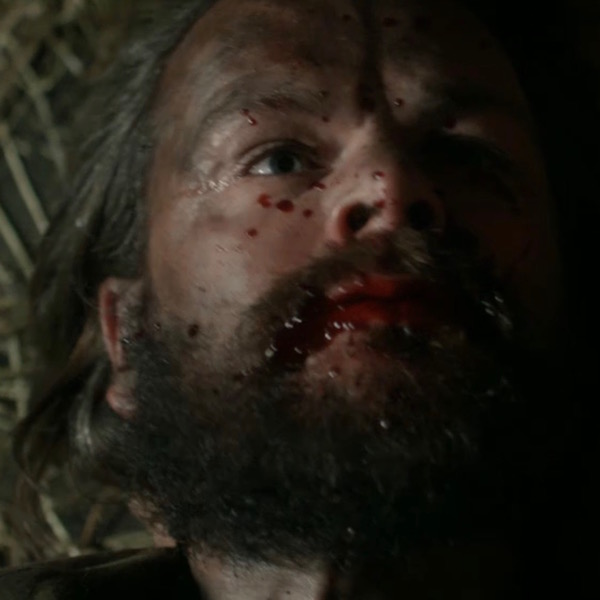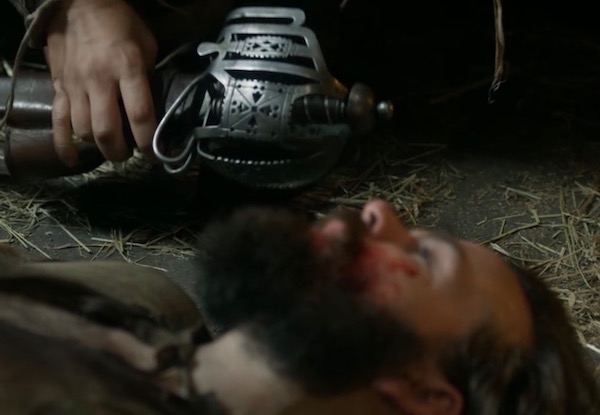Three weeks ago, after posting Anatomy Lesson #41, The Sad Demise of Angus Mohr, I promised I would blog about my Scotland Outlander Immersion Tour. Family and friend’s summer visits are also over so it is “show and tell” time.
What follows in this blog is part one of my splendid 2016 Scotland Outlander Immersion Tour. Mind, I did not know Scotland was on the horizon this year. The trip was a gift from conniving hubby of 53 years aided by an equally sly oldest daughter.
We left the Pacific Northwest in early June, over-nighted in D.C., flew to Reykjavik, Iceland (Photo A), and finally landed in Glasgow. Why did we fly 8,312 convoluted miles when only 4, 572 miles separate Oregon and Glasgow? Only hubby knows! Just joshing. It is because these days, Icelandair tickets are very affordable.
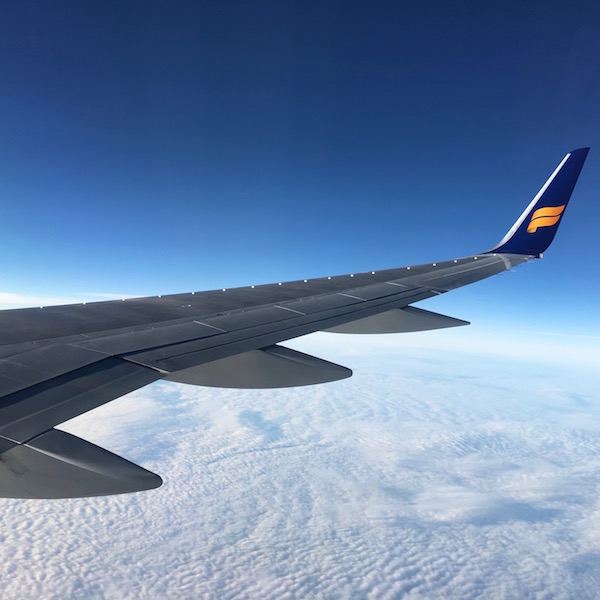
Photo A
Arriving at noon in Glasgow, we immediately hailed a taxi to Every Day Athlete (EDA) Gym as I was late, I was late, for a very important date: a personal training (PT) session with this handsome Irish lad, Patrick O’Brien, co-owner of EDA Gym (Photo B). A multi-talented man, he also acts in theater, films, and some TV.
EDA Gym is the establishment that partners with Sam Heughan to produce the MyPeakChallenge (MPC) program. If you are not a MPC member, you might consider joining. The program focuses on improving personal health through exercise and diet while raising money for Sam’s Bloodwise charity, a worthy cause supporting research into all forms of blood cancers. This year the MPC raised a staggering £225,000 ($295,000 US).
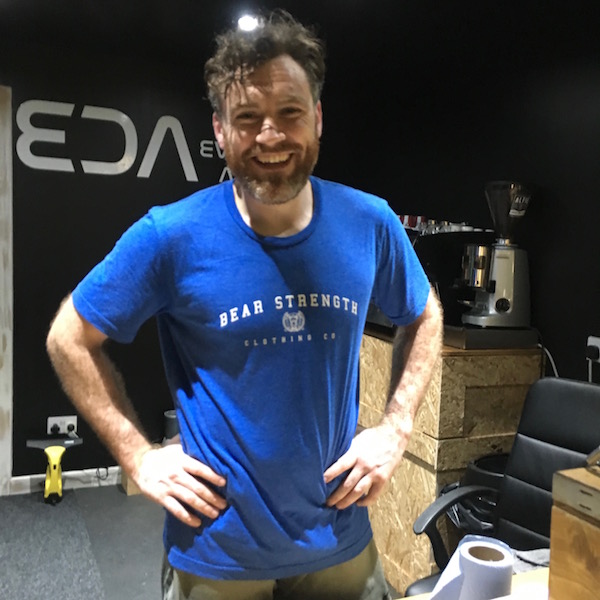
Photo B
Gentleman Patrick wasn’t prepared for my almost 74 y.o. body (I did not warn him about my age) and given that I had flown all night, went fairly easy on me despite pushups, lunges, kettle bells, and shoving around this nasty hunk of steel affectionately known as “the prowler” (Photo C). The apparatus, which in my view should be more aptly named “The Beast,” had only 25kg added weight – a nearby prowler held an additional 75kg! A young laddie walked by and taking pity on my (ahem) struggles with the metal monster offered encouraging words. I needed them!
Patrick was friendly, welcoming, helpful, competent, and professional and gave me a great PT session. Thank you, Patrick! More about him in my next installment.
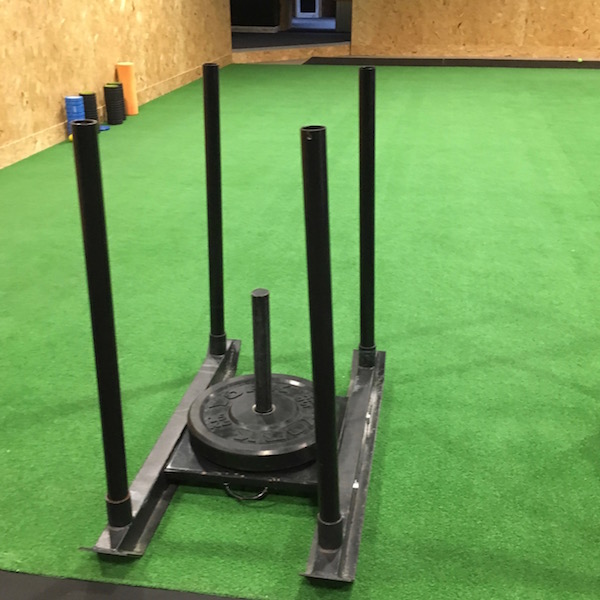
Photo C
After the PT session, I found a quiet corner and zoned into my usual 45 minute yoga routine while the room echoed with grunts, blows, and whacks from male and female members who were sparring with Muay Thai combat sport (Photo D). Grins were apparent despite the intense competition. Cooling down, a very friendly Jamie, cousin to John Valbone (co-owner), wanted to talk. Guess what we talked about? Anatomy and physiology, naturally!
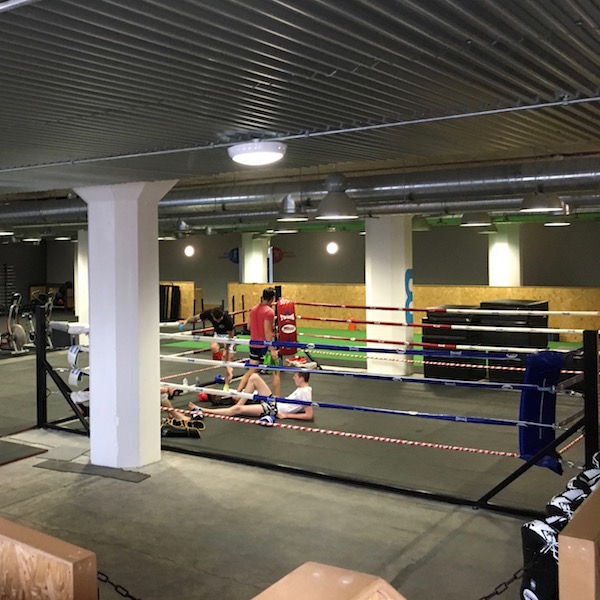
Photo D
Being retired academics, the next day found my husband and I trekking to the University of Glasgow. Crossing the River Kelvin, we were greeted by a statue of Lord Kelvin, the great mathematical physicist and engineer (Photo E). This Irish-Scottish scientist taught at the University of Glasgow for 55 years! During that time, he invented a maritime compass and a tide gauge, worked out problems for laying the first transatlantic telegraph cable, and accurately determined the temperature of absolute zero for which he is rightly honored by the temperature measurement, degrees kelvin.
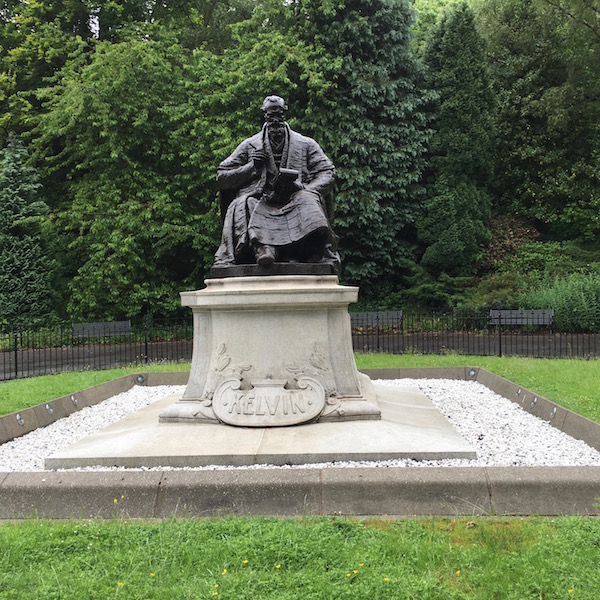
Photo E
If we thought the University of Glasgow was just another academic institution (we did not!), we were quickly disabused of that notion as it was founded in 1451 and is the fourth oldest university in the English-speaking world! It has produced some of the most famous physicians, mathematicians, and engineers of the scientific arena. Its iconic stone bell tower dominates the horizon making it very easy to locate (Photo F).
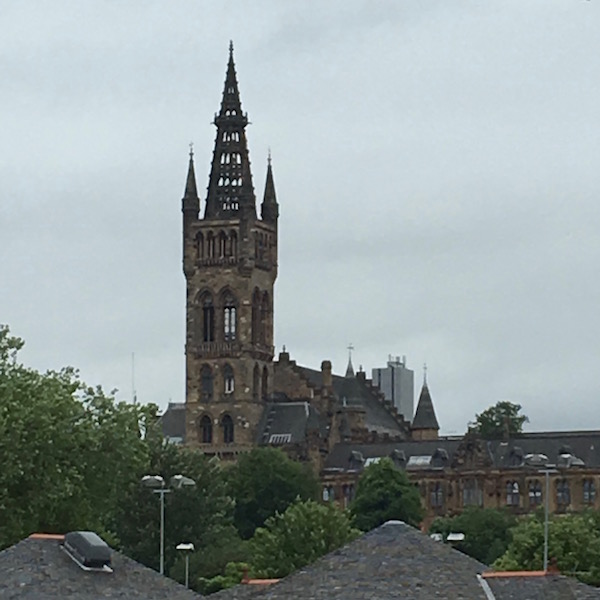
Photo F
At the University, I quickly made a bee-line for The Hunterian Museum, the oldest public museum in Scotland. Named for William Hunter (1718-1783), physician, scientist, and anatomist (fist pump!), he is famous for studies of cartilage and bone. The museum houses not only his anatomical, zoological, and scientific instruments, but also a fine array of coins, minerals, paintings, prints, and books as well as geological, archaeological, and ethnographic collections (Photo G). A reminder to book readers: Diana briefly writes about William’s brother, John (also physician and anatomist), in her 7th book, “An Echo in the Bone.”
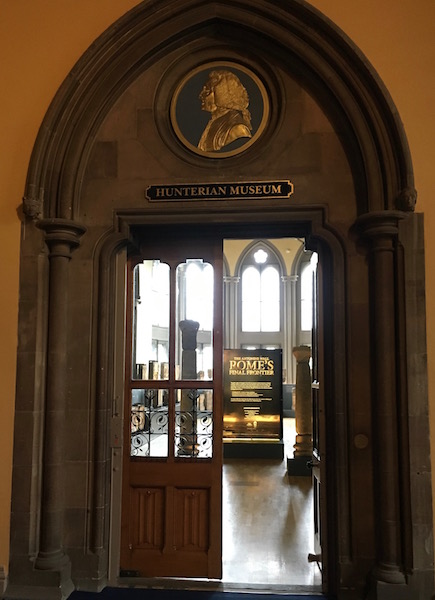
Photo G
This poorly healed fracture of a left tibia is one among many fascinating Hunterian specimens (Photo H). The fracture was not reduced properly (or at all) so the bony parts healed in an overlapped position (Anatomy Lesson #40, “Snap, Crackle, Pop! or How Bones Heal”). The healed leg was likely 2-3 inches shorter than the presumably normal right leg and the sufferer undoubtedly had great difficulty walking; reminded me of Colum’s poorly mended limbs (Anatomy Lesson #27, “Colum’s Legs and Other Things too!”).
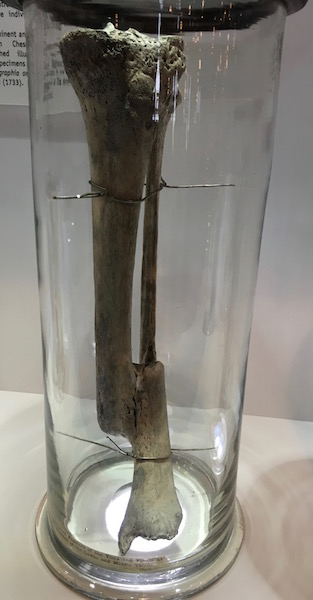
Photo H
Last image is William’s microscope (Photo I). Although a beautiful instrument, it is a far cry from today’s powerful light microscopes (Anatomy Lesson #34, The Amazing Saga of Human Anatomy). William lived during the Scottish age of enlightenment (1600-1800) when scientists challenged superstition and injustice by arguing for the use of reason. Scotland was a leader in that movement causing the French philosopher, Voltaire, to comment “We look to Scotland for all our ideas of civilization.” Oh, and in case book readers forgot, Diana also includes Voltaire in her third book, “Voyager.” Go, Diana! Rah!
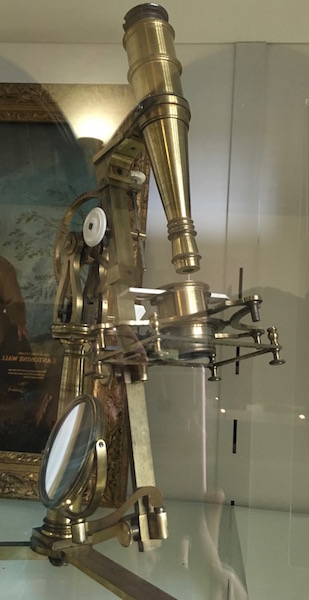
Photo I
A quick hike down the street To visit Glasgow’s Botanic Gardens, featuring the famous and stunning Kibble Palace, erected in 1873 (Photo J). The site includes several glass buildings each containing a wondrous array of everything plant.

Photo J
My personal favorite was a room titled “Dangerous Plants” which contains “Little House of Horrors” – type specimens (Photo K) such as these ethereal but deadly pitcher plants, able to digest insects as well as small vertebrates such as frogs and wee snakes. I felt right at home as we have our own version of pitcher plants here in the Pacific Northwest at Darlingtonia State Natural Site.
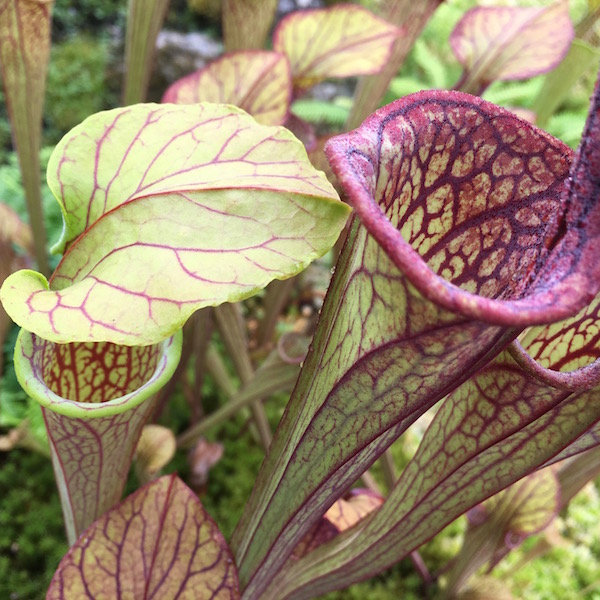
Photo K
Evening found us back at the inn, foot weary but deeply gratified after 6+ miles of stumping Glasgow’s streets and sidewalks. That evening our seven tour members met for a personal concert by Gillebrìde MacMillan, better known to us as Gwyllyn the Bard. He shared a number of Gaelic ballads rendered in his fabulous a cappella tenor voice.
He also shared this fun story: Planning to arrive well-groomed, he got a hair cut before filming his wonderful singing sequence for Starz episode 103, The Way Back. However, Outlander hair folks were bummed because they had planned to attach a wig using his own locks! Sans that option, they resorted to glue. According to Gillebrìde, removing the sticky stuff was verra painful!
Gillebrìde ended his performance by showing a painting recently presented to him by a fan (Photo L). We all agreed it was an excellent rendering of him as Gwyllyn the Bard. As Jamie once said, “The Welshman would be welcome at any Laird’s hearth” (Starz episode 103, The Way Out).
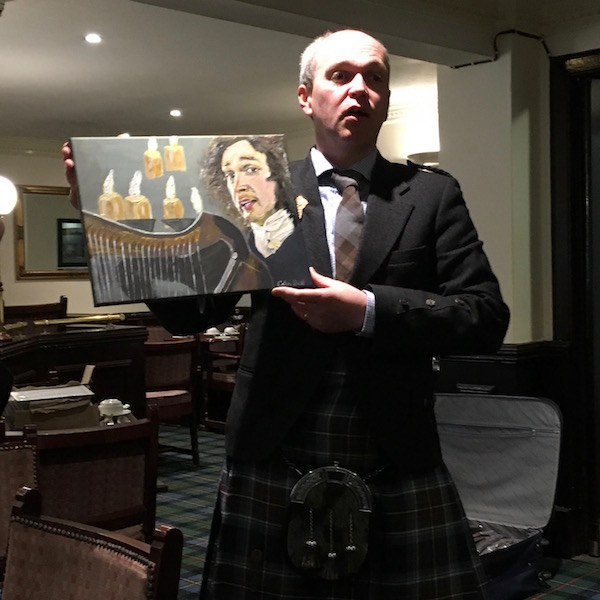
Photo L
The following morning, we boarded a comfortable, roomy, custom-made van. Our group included folks from Canada, Florida, Indiana, and Oregon. Our tour guide was Scotsman, Hugh Allison. Tall, ginger-haired, gregarious, and knowledgeable, he was the perfect resource for us Outlander-hungry fans. Topping it all off, Hugh is also a Gaelic-speaker so he was able to translate the language and was an endless source of Highland tales and history. Off to a grand start!
Our first stop was Doune Castle in the Sterling district (Photo M). This imposing ediface served as Castle Leoch and was also featured in that delightful British film, Monty Python and The Holy Grail.
We happily climbed stairs, visited the kitchen, admired the great hall, and saw the lord’s tower, curtain wall, music gallery, cellars, and courtyard.
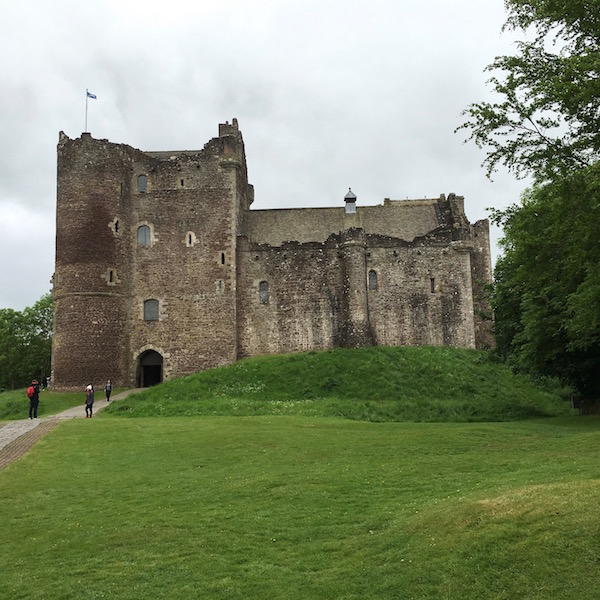
Photo M
Clearly, Castle Doune and Castle Leoch are dopplegangers as evident from this scene when Claire, Jamie and Dougal’s party approach the castle courtyard (Starz episode 102, Castle Leoch).
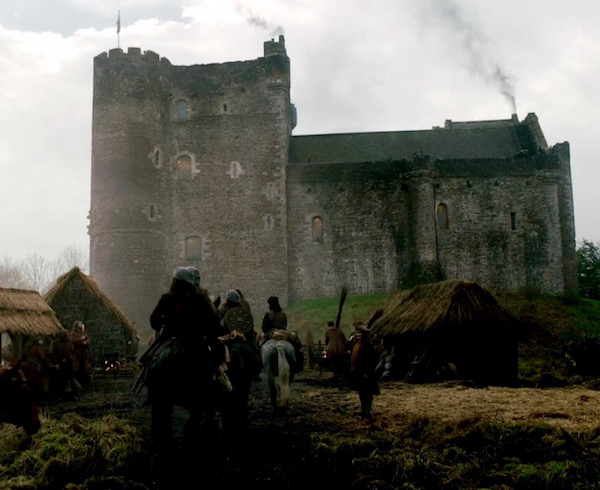
The Doune kitchen sports a massive 16’ open oven, large enough to roast an entire ox with room to spare (Photo N)! It even has its own drain (left back corner) into which residues were flushed.
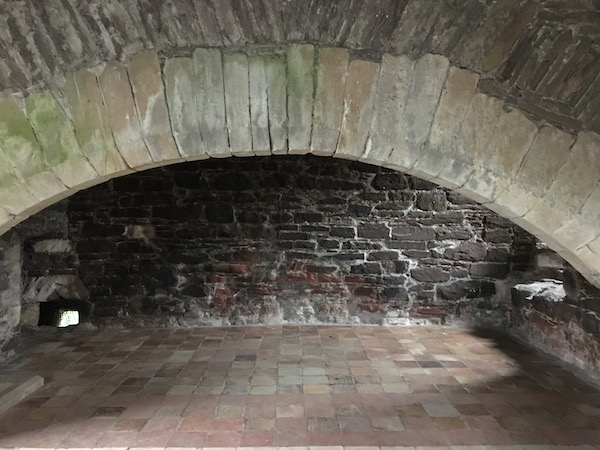
Photo N
Doune oven served as prototype for the set version of Castle Leoch’s puir oven (or so says Letitia) – the one used to roast dozens of birds as beloved Mrs. F trills, “Baste it, girl, baste it!” (Starz episode 104, The Gathering).
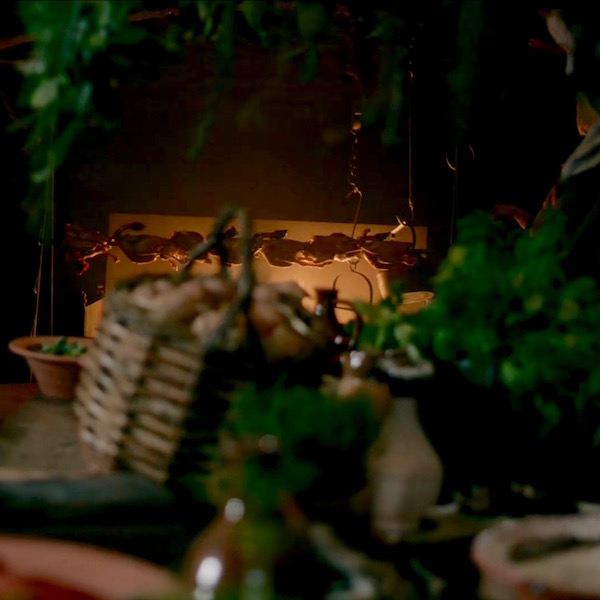
Outdoors, along the east wall of Castle Doune, a charming, grassy flower-strewn field grabbed our attention (Photo O).
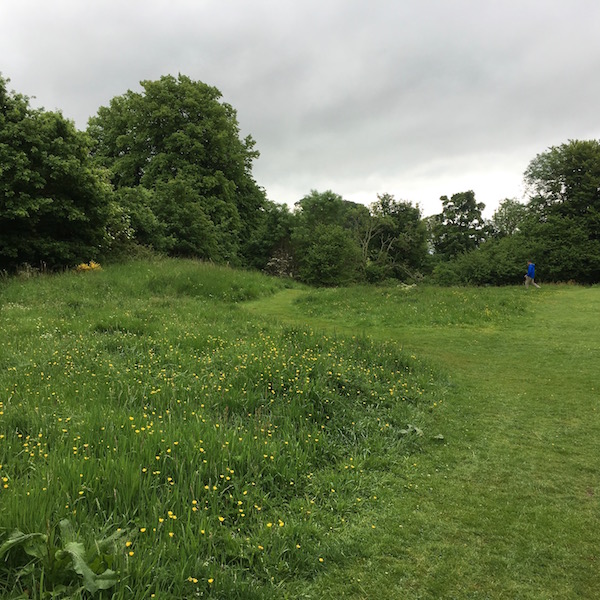
Photo O
We were delighted to discover this verdant pasture was also site of the shinty game (Starz, episode 104, The Gathering) where team-Jamie was doing swell until Dougal laid waste to a number of combatants as he wielded his kilt-kick and shinty-stick! There’s Jamie hoofing it down the center!
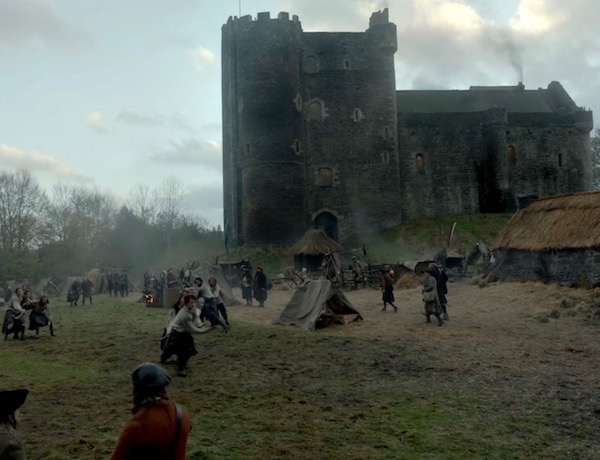
Leaving Castle Doune, we motored to Falkland, the village posing as 1945 Inverness. Here we wandered the streets, checked out sites, and enjoyed a delicious lunch at a local pub. A beautiful stone fountain dominates the town square (Photo P).
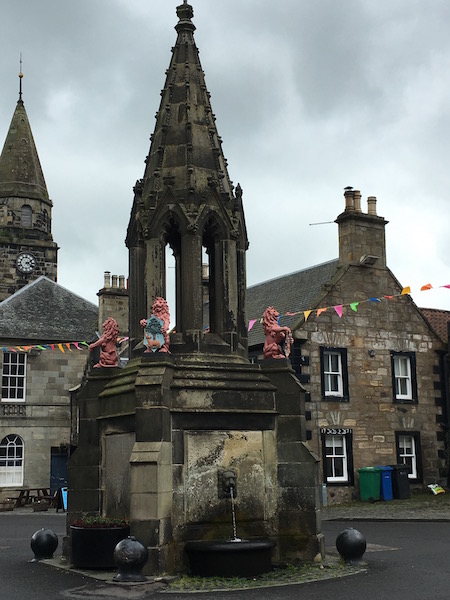
Photo P
You have seen this fountain before. Recall Starz episode 101, Sassenach? Of course ye do! Jamie’s ghost waits at the fountain, standing in the pouring rain, as he watches Claire fight her curls and swear in the upper right window of Mrs. Baird’s Bed & Breakfast. Same corner window, same corner of fountain. Score!
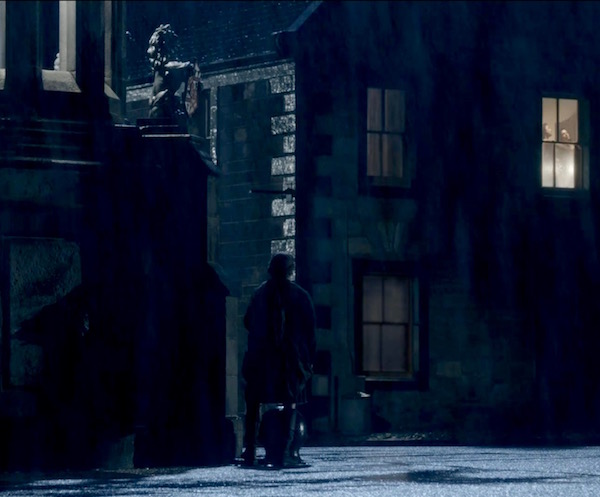
On main street is a quaint general store specializing in curios (Photo Q).
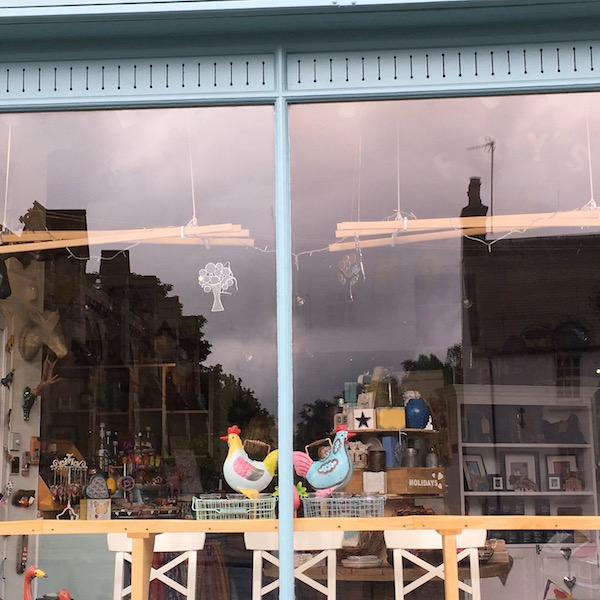
Photo Q
Mayhap you recognize it as the same window where Claire, who has never owned a vase, contemplates buying one (Starz, episode 101, Sassenach). From Outlander book:
My gaze lingered on a shop window filled with household goods—embroidered tea cloths and cozies, pitchers and glasses, a stack of quite homely pie tins, and a set of three vases.
I had never owned a vase in my life.
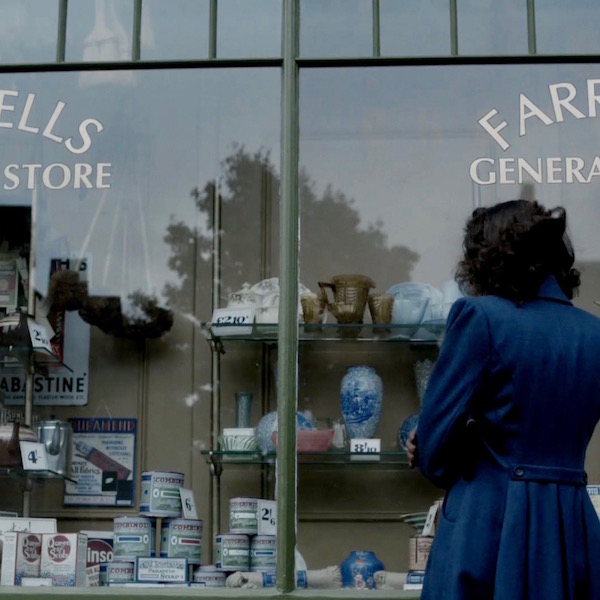
Evening found us in the quaint town of Aberfeldy where we enjoyed superb lodgings, nestled amid beautiful highland hills. We spied an iconic red British phone box (Photo R) but, sadly, no Dr. Who with his blue tardis to whisk us back to 18th century Jamie!
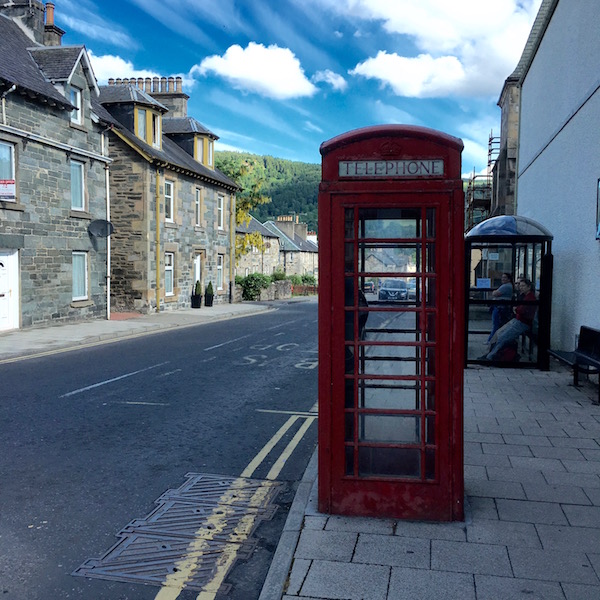
Photo R
Next morning, I enjoyed an awesome breakfast (Photo S) – steamy, creamy parritch laced with whisky! Oats were cooked in cream with just a hint of whisky flavor. Divine!
King Louis really didn’t know what he was missing (although Jamie did leave out the whisky bit). Instead, Louis declares through gritted teeth “The King has never acquired a taste for peasant food…” (Starz episode 202, “Not in Scotland Anymore.” ). Course, that is why he was straining on the royal pot, puir king!
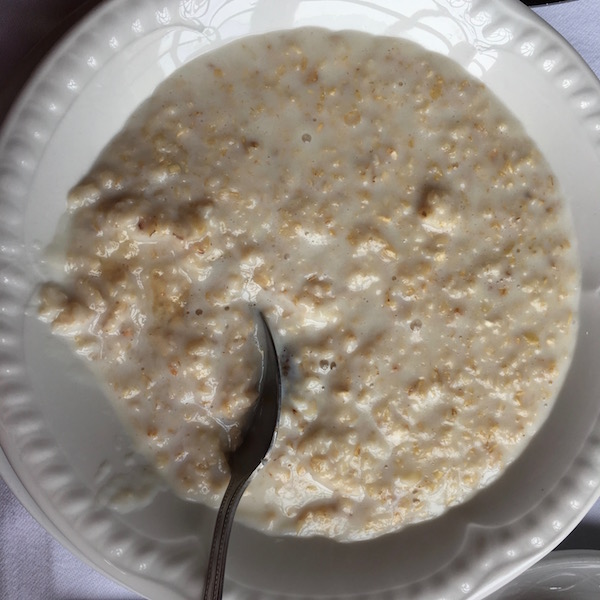
Photo S
After breakfast, our group assembled on the steps of the inn where we were joined by guess who (Photo T)? No, not Rupert and Angus (although that would have been fun!) but our favorite Highland couple were waiting to greet us. They were rarin’ to go!
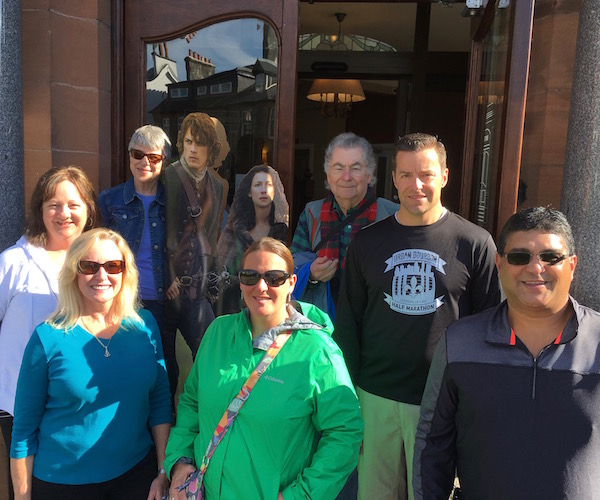
Photo T
Our travels quickly took us past the Scottish village of Dull, sister “city” of Boring, Oregon (Photo U). I know Boring very well as my hair dresser has a salon there, a scant ten miles from my home. Dull and Boring – a match made in heaven. Snort!
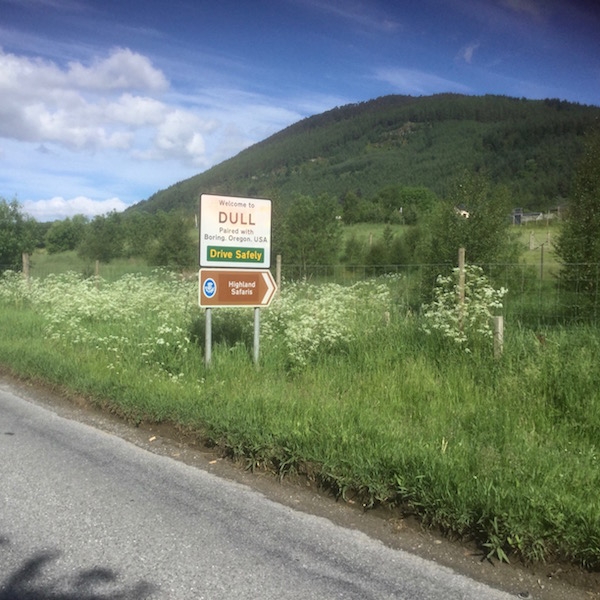
Photo U
Later that day as we motored under bright blue skies dotted with white, fluffy clouds, Hugh pulled the van over and suggested we take a little “walk in the heather.” Stepping out of the van, we were thunderstruck at the sight! In the distance was a modest grass-covered dun, it’s only inhabitants a herd of beautiful Highland Cheviot sheep.
We approached the site with an almost reverential attitude because we had arrived at Craigh na Dun (Photo V)! There stood the grassy knoll where Claire and Frank watched Mrs. Graham lead her followers in the ancient Druid ritual to call up the sun. This was the hill where Claire Beauchamp Randall places her hands on a standing stone and travels 202 years into the past! Here was the site where Claire’s heart breaks as she leaves Jamie to return to her own time. OK, I confess, I shed a few tears, and the place gave me goose flesh (Anatomy Lesson # 6, “Claire’s Hair – Jamie’s Mane” or “Jesus H. Roosevelt Christ!”)!
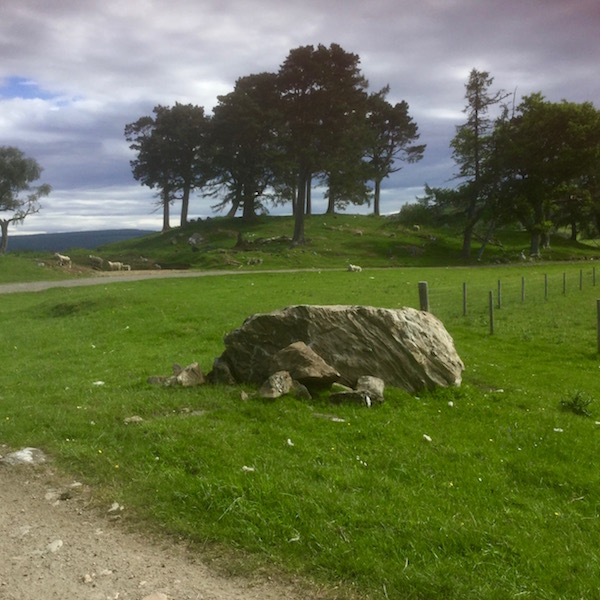
Photo V
Atop the dun, the site enjoys no standing stones but it was a perfect place to re-recreate that pivotal moment when time performs its daring flip-flop. The hill bears patches of turf where the stones were erected and then removed. Kudos to the Outlander crew for returning the site to what appeared to be its original state (Photo W)!
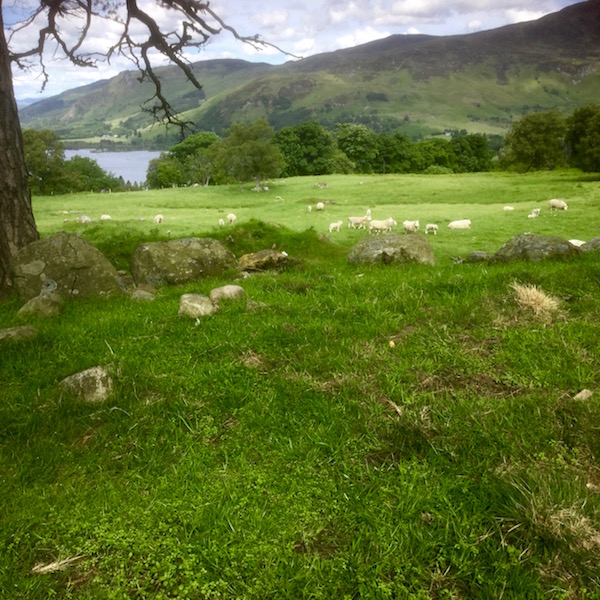
Photo W
A friendly wooly ewe and two darling lambs eyed us a little warily (Photo X – one babe is behind her rump). She was very curious about us time travelers. Apparently, we were messing with her fairy hill.
I swear the place is more than a bit eerie. Weather started out quiet and very still; moments later, the sky changed from bright blue to overcast and the wind came up sharply and bit through our jackets. Unlike the ewe, we had no wooly coat to keep us toasty warm.
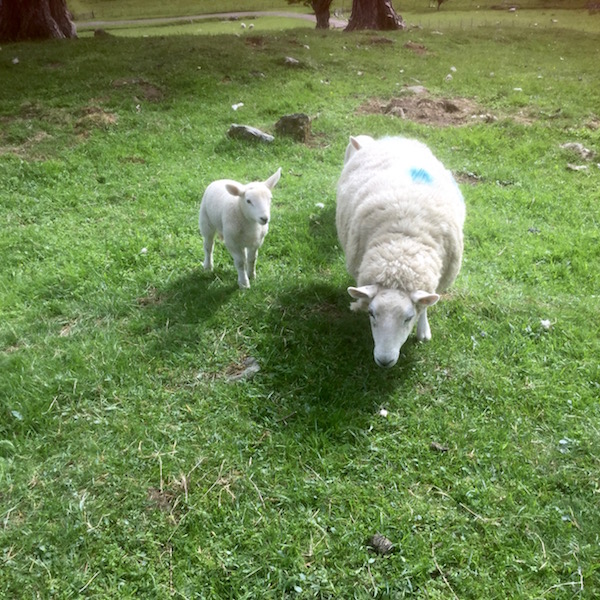
Photo X
Turning to the west, ewe, oops, I mean you might recognize the next view. Atop the grassy Craigh, we see distant lochs visible in Starz episodes 101, 108, 111, and 213 (Photo Y).
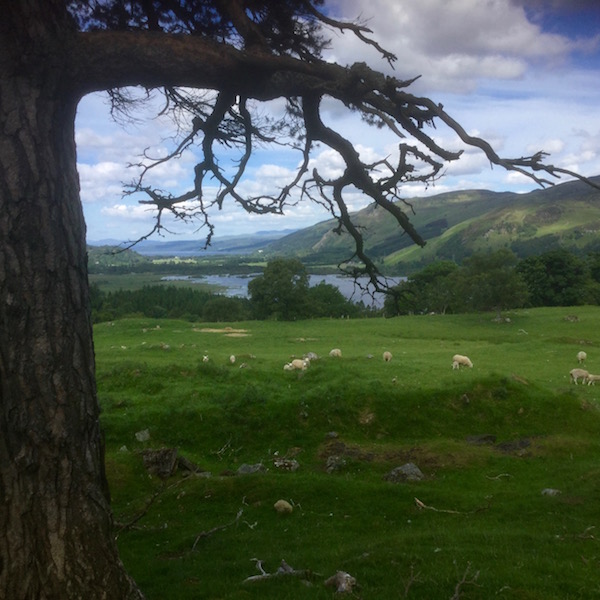
Photo Y
Different time of year and different photo angle but the same site where Jamie and Claire prepare for her passing through the stones, back to her own time….back to Frank (Starz episode 213, Dragonfly in Amber). Sob!
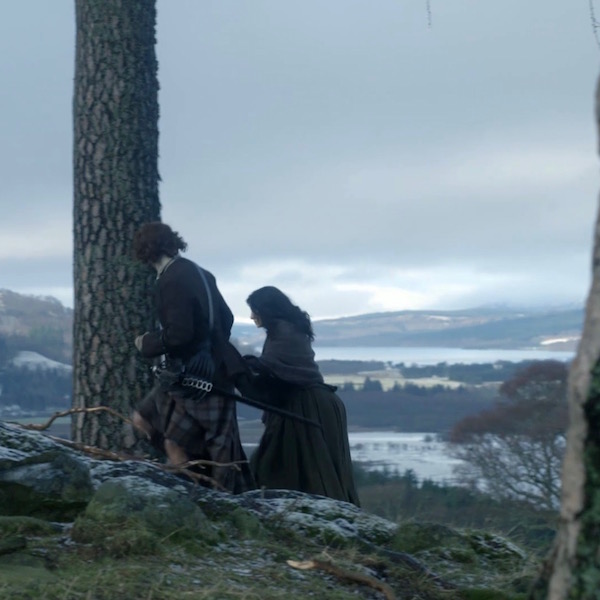
Are you a wee bit dubious that this is “the place”? Then, please note the bent tree on the far side of the hill, a sure sign of Craigh na Dun (Photo Z)! “Green, green, it’s green they say, on the far side of the hill!”
BTW, the rosy hue of the sky and treetops isn’t due to sunset or the northern lights, it is caused by finger-near-the-lens syndrome – sure sign of a freshman photographer. Let’s just say the fairies did it!
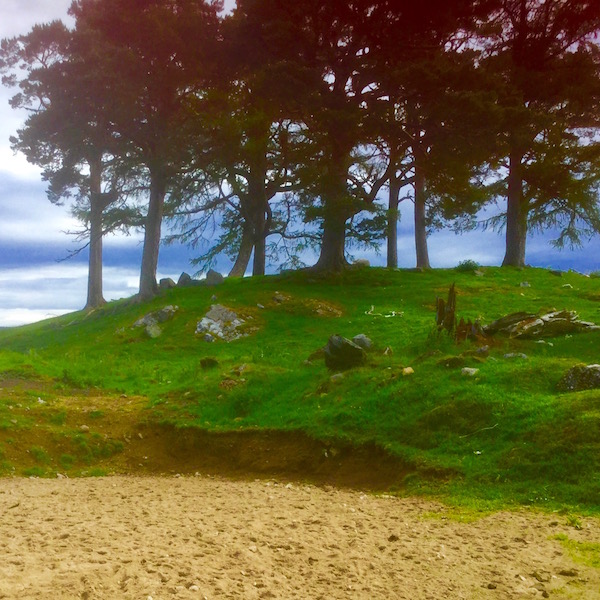
Photo Z
This is the same bent tree the dancing Druid sits on after returning for a lost bauble (Starz episode 101, Sassenach).
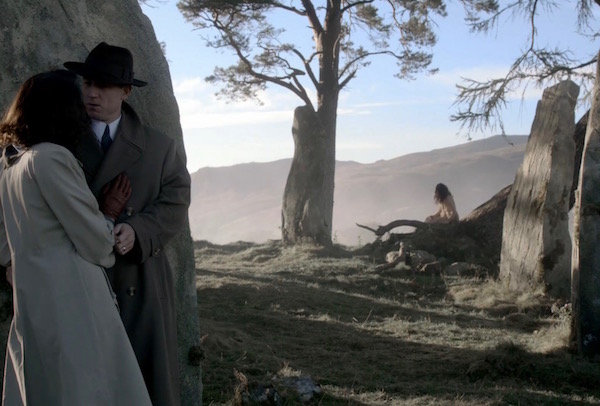
And, the same bent tree from the last scene of Outlander season two as Claire watches a glorious sunrise over the largest stone – her precious portal back to Jamie (Starz episode 213, Dragonfly in Amber)!
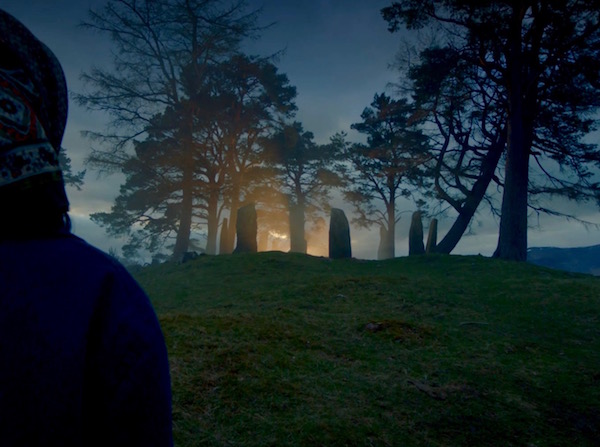
Then, it was our time to depart. Buh bye, Craigh na Dun (Photo ZZ)! So sad, feeling bad, but time to go. Tick tock; tick tock

Photo ZZ
From A to ZZ, you have seen the first part of my marvelous Outlander tour. More fun Outlander sights and sites in the next blog. Watch for it!
A deeply grateful,
Outlander Anatomist!
Photo creds: Starz, Outlander Anatomy

